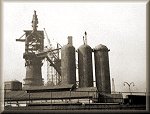|

3. An account of Alfred Hickman Ltd. in 1898
We now take information from an article in
Wolverhampton and South Staffordshire Illustrated. It was published
in about 1898 and provides much useful information. However, it as
an advertising or PR publication, and it was designed to say the
best possible things about each of the companies mentioned – all of
whom had paid for inclusion in the publication, either directly or
by buying copies for distribution. So the reporter is never short
of flowery language and high praise.
The article mentions two works belonging to
Alfred Hickman Ltd. : the Staffordshire Steel and Ingot Works and
the Spring Vale Works. But then their description of the company
carries on as if there was only one site. This is because originally
there had been two firms on the site, the Springvale Furnaces Ltd
and the Staffordshire Steel and Iron Ingot Co.. They amalgamated in
1897 to become Alfred Hickman Ltd.. The article also says that the
site includes “adjacent collieries and brickworks”
The site is described as being of about 200
acres; connected by sidings to the main line of the London and North
Western Railway and of the Great Western Railway; and having
extensive wharfage on the Birmingham Canal. The site is also
“traversed by about ten miles of railway and tram lines, on which
the firm’s own locomotives are employed for haulage purposes”.
The works provided employment for about 1,500
people. The writer comments that the works present “a scene of busy
activity by night and day”. In the nature of the industry, 24 hour
working usually took place. One hopes it was assisted by the
electric lights.
At the entrance to the works are “handsomely
furnished suites of private offices and general offices” and two
“fully equipped chemical and metallurgical laboratories, where
analytical and experimental work and research are carried out”.
Then the writer gets to the technical stuff, which he may or may not
understand:
He says that “the iron ore
is obtained partly from the Astrop mines in Northamptonshire, and a
large bulk is received in a calcined state, conveyed in railway
trucks of special design”. Where the rest of the ore comes from, he
does not say. “The ore is discharged into the hoppers by the side
of the line, from whence it is transferred to barrows for transport
to the blast furnaces”.
There were six blast
furnaces, each 60 feet in height, and eleven large stoves, connected
with which are five blowing engines from l00 to 400 horse‑power.
Three furnaces were worked for making Basic pig, and three kilns
were used for calcining the ore.
In another part of the
works the writer found “a complete plant of ballast moulding
machines, on Moore’s patent principle, for the manufacture of
ballast used in railway construction and maintenance”.
The output of pig iron
averaged 2,000 tons per week, some of which was used by Hickmans,
and the rest sold to other manufacturers in the district. “The
Bessemer process plant comprises three 12‑ton converters, with an
out‑turn capacity of 1,500 tons of steel ingots per week. The
converters are supplied with blast by two powerful blowing engines,
and connected therewith are large cranes worked by hydraulic
pressure.”
“In the mill department
the outfit includes four reheating furnaces in a new type of
Siemen’s regenerating apparatus, and the cogging mills are fitted
with hydraulic gear, worked with patent tilting attachment driven by
an engine.”
At this point I have to
admit that I do not what he is talking about. I sometimes have my
doubts as to whether or not he does. He is probably dealing with the
area f the works where iron or steel was reheated so that it could
go through the cogging mills, which were rollers which rolled the
steel into flat plates.
The writer continues:
“Other noteworthy features of the plant are the ponderous
horizontal hot shears, which operate on the metal in manner similar
to ordinary scissors on cardboard; and a 24in. bar mill, rolling
large sections in bar, up to 16in. in flats, 8in. in rounds, and
8in. by 8in. in angles.
“The plate rolling mills
are furnished with plant producing plates of the largest size for
engineering and constructive works, some of these measuring 6ft. in
width and weighing up to three tons. These mills are driven by three
pairs of engines of 2,600 horse‑power combined.
“The 15in. bar mills are
worked for rolling small sections, and, with the 24in. mills, are
driven by engines of 690 horse‑power combined; the plate mills by
engines of 600 horse‑power, driven by independent engines; cogging
mills, 560 horse‑power; blowing engines, 500 horse‑power; and hot
shears, 150 horse‑power. Steam for the engines is generated by two
batteries of 17 large boilers, 30ft. long by 8 ½ ft. diameter, fired
partly by means of the waste gas from the furnaces.
“The works are lighted
throughout by an electric installation, the dynamos being driven by
a splendid compound condensing engine of 350 horse‑power, laid down
by the Lilleshall Engineering Company, Salop.” Presumably this
condensing engine provided power for the generating equipment
provided by the ECC.
 |
|
 |
|
 |
Return to
Alfred
Hickman |
|
Return to
the
beginning |
|
Proceed to
Basic Slag |
|